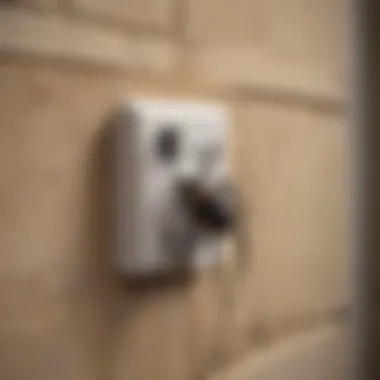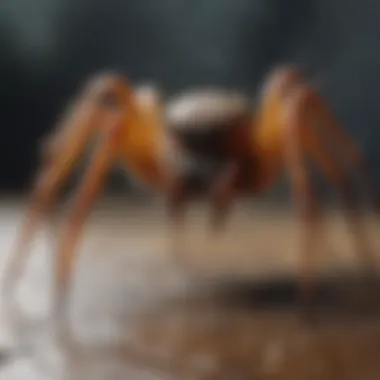Effective Wall Plug Devices to Repel Spiders


Intro
Spiders are a common nuisance in homes and can evoke a range of reactions, from mild discomfort to outright distress. It is essential to understand these creatures to address the growing concern of their presence effectively. The widespread use of wall plug devices represents a modern approach in pest management, particularly tailored towards spider control. These devices promise ease of use and a less invasive solution compared to traditional methods. In this article, we will explore the mechanics of these devices, delve into spider biology, and examine how effective these gadgets are in creating a spider-free environment.
Understanding the Pest
Identification
The first step in managing spiders is to identify the species present in your home. Spiders vary significantly in size, color, and behavior. Common household spiders include the common house spider (Parasteatoda tepidariorum), known for its web-spinning, and the black widow (Latrodectus hesperus), recognized by its shape and distinctive markings. Understanding the identifying characteristics of these spiders helps in realizing whether they pose a threat or are simply harmless inhabitants of your space.
Life Cycle
Next, it is crucial to grasp the life cycle of spiders. A typical life cycle includes four stages: egg, juvenile, subadult, and adult. Female spiders often lay eggs in silk sacs, with some species producing dozens at a time. The number of eggs and the duration of each stage can vary greatly between species, with some capable of producing multiple generations in a year. This knowledge aids in comprehending why certain areas of the home may experience spider infestations more than others.
Pest Prevention Strategies
Environment Modification
A well-maintained environment is your first line of defense against spiders. Eliminate hiding spots by regularly cleaning spaces, closing gaps in windows and doors, and ensuring that foliage is trimmed back from the structure of the home. Utilize vacuuming and sweeping to remove webs and egg sacs, reducing potential food sources and breeding grounds.
Physical Barriers
Implementing physical barriers can significantly lower spider intrusion. Install screens in windows and check for cracks or openings around doors. Seal these to restrict spider movement.
Control Methods
Chemical Control
While some may resort to chemical insecticides, caution should be taken. Many products on the market claim to repel spiders but might not target them directly. Some of these products can pose safety hazards, especially in homes with children or pets. Research indicates a strategic use of these chemicals may be more effective, applied in areas where spiders are frequently seen without compromising household safety.
Biological Control
An alternative is biological control, which involves using unrelated predators to manage spider populations. For instance, encouraging the presence of birds or geese can naturally control insect populations that are food sources for spiders. This method promotes a balanced ecosystem in and around your home.
A combination of prevention strategies and control methods is key to effective spider management.
Culmination
Utilizing wall plug devices offers a novel complement to traditional pest management techniques. Combining knowledge about spider biology and proactive prevention can create a safe and comfortable living space, free from unwanted guests. As homeowners navigate their pest control strategies, awareness and informed decision-making are paramount to achieving enduring results.
Understanding Spiders and Their Behavior
Understanding spiders and their behavior plays a crucial role in utilizing wall plug devices effectively. This foundational knowledge aids homeowners in recognizing the ways these creatures inhabit and thrive within domestic spaces. House spiders, in particular, are not merely nuisances; their presence can indicate environmental conditions that may need to be addressed. By grasping the nuances of spider biology and preferences, users can strategically deploy repellents, including wall plug devices, aiming for greater efficacy in spider deterrence.
Characteristics of Common Household Spiders
Common household spiders exhibit distinct physical and behavioral traits that set them apart. They range in size, color, and web structure. For instance, the common house spider, known scientifically as Parasteatoda tepidariorum, is usually brown and can be recognized by its characteristic messy webs. Other species, like the black widow, are more dangerous but less common in homes.
Each species has its own life cycle, often starting with egg sacs that can contain dozens of eggs. Spiders are predators, feeding on insects, which means they may indeed be beneficial in terms of controlling pest populations. Understanding these traits allows homeowners to identify species correctly, especially when addressing infestations or deciding on control measures.
Spider Preferences in Environment
Spiders have specific environmental preferences that make certain areas of a home more attractive. They favor dimly lit corners, attics, basements, and spaces that provide hiding spots, such as behind furniture or under appliances. Humidity plays a major role, as many spider species thrive in moist areas. This proclivity for specific environments compels homeowners to assess these spaces regularly, which aids in preemptive spider control.
Moreover, clutter can significantly increase spider habitation. Tidying up and removing unnecessary items can minimize potential hiding spots, thus discouraging spider colonization. Homeowners need to be aware of how their living conditions permit spider habitation.
Reasons for Attractiveness to Homes
Several factors contribute to why spiders are drawn to residential areas. First, the presence of food sources—like flies, mosquitoes, and other insects—provides an inviting environment for spiders. Homes often provide an abundant supply of insects, especially in warmer months.
Second, structural elements of a house such as cracks, crevices, and insulations can serve as ideal entry points for spiders. Additionally, the consistent temperature and shelter from environmental elements make homes more appealing. Understanding these reasons equips homeowners with the knowledge needed to implement preventative measures.
"By recognizing the reasons spiders are attracted to a home, one can take effective actions to limit their presence and enhance the comfort of living spaces."
In summary, a comprehensive understanding of spider behavior, characteristics, and preferences can enhance the effectiveness of wall plug devices and other pest control methods. This knowledge assists homeowners in creating an environment that is less suitable for spiders, ultimately leading to a more comfortable living space.


The Science of Repellents
Understanding the science of repellents is crucial when considering how to effectively deter spiders from one's home. This section will delve into the types and mechanisms of action relevant to the use of wall plug devices. By comprehending the different types of repellents and how they function, house owners can make informed decisions on effective pest control. It can also help in assessing benefits and considerations associated with various approaches. This information is vital for homeowners aiming to create a safe and spider-free environment.
Types of Repellents
Chemical Repellents
Chemical repellents are substances specifically formulated to prevent spiders and other pests from entering indoor spaces. One of the most significant characteristics of chemical repellents is their ability to affect the sensory perception of spiders. This causes them to stay away from treated areas. Many homeowners opt for chemical repellents due to their proven effectiveness in a variety of situations. However, one should note the potential toxic effects on non-target species, including pets and small children. It is important to consider safety and proper application when utilizing these products in residential settings. The main advantage is their immediate impact, although prolonged use may lead to pest resistance.
Ultrasonic Devices
Ultrasonic devices operate on a completely different principle than chemical repellents. These devices emit high-frequency sound waves that are unpleasant to spiders and other pests, disrupting their normal behavior patterns. A key characteristic of ultrasonic devices is that they are non-toxic and safe for both humans and pets, making them a popular choice among families. The unique feature of these devices is their ease of installation—simply plug them into a wall socket, and they start working immediately. However, the effectiveness can vary; some users report success, while others find limited results. Overall, their non-invasive nature is a strong point, though it’s essential to set realistic expectations regarding outcomes.
Mechanisms of Action
Physiological Effects on Spiders
The physiological effects of various repellents significantly contribute to their efficacy. Chemical repellents often disrupt the spider's ability to sense its environment. This disruption can hinder their ability to hunt or reproduce effectively. Because spiders rely heavily on their sensory organs, affecting them can lead to reduced populations over time. This is a beneficial aspect that homeowners look for when setting up pest control measures. However, careful application is necessary to prevent unintended consequences on surrounding ecosystems.
Behavioral Disruption
Behavioral disruption plays a critical role in the functionality of ultrasonic devices and chemical repellents alike. Ultrasonic sound waves can create an uncomfortable environment, prompting spiders to vacate the premises. Similarly, chemical scents can alter their normal behavior, leading to avoidance of treated areas. A key benefit of understanding behavioral disruption is developing strategies that can be employed in conjunction with wall plug devices. Nevertheless, one must be aware that efficacy might vary based on the spider species present, requiring adjustments in approach accordingly.
Operational Mechanisms of Wall Plug Devices
Understanding the operational mechanisms of wall plug devices is crucial for appreciating their effectiveness in repelling spiders. These devices are designed with specific features that facilitate their function, contributing to a more spider-free environment in homes. Knowing how these mechanisms work can help homeowners and housewives make informed decisions about pest control.
Design and Components
The design of wall plug devices typically encompasses a compact and user-friendly form. Most devices have a casing made from durable plastic, which houses the internal components. Key elements inside include an ultrasonic emitter and, in some advanced models, a light sensor. The ultrasonic emitter produces sound waves that are inaudible to humans but disruptive to spiders and other pests. The simplicity in design allows for easy placement in various locations around the home, enhancing their usability.
Some devices might also feature indicators such as LED lights that show when the device is operational. This provides clarity on whether the unit is functioning correctly. Overall, the intentional design makes the devices aesthetically unobtrusive, allowing them to blend into household environments while actively working against spiders.
Power Sources and Electricity Use
Wall plug devices primarily use a direct electrical connection to operate. They generally plug into standard wall outlets, relying on household electricity for power. Most devices consume minimal energy, which makes them cost-effective for long-term use.
In terms of electricity use, these devices do not require special installations. The standard plug-and-play mechanism ensures quick setup. Users should be aware that while they are energy efficient, using many devices simultaneously could lead to higher overall electricity consumption. Keeping this in check is essential for both cost and ecological considerations.
Installation Procedures
Installing wall plug devices involves a straightforward process. Users should find a standard outlet where spider activity is prevalent, such as near windows, corners, or entry points.
- Choose Location: Select areas prone to spider sightings or web formations.
- Unpack Device: Remove the device from its packaging and ensure it is functioning by checking indicator lights, if available.
- Plug In the Device: Insert the device into the outlet. Ensure it is firmly in place.
- Test its Reach: Consider the coverage area by placing multiple devices if necessary. Each unit can typically cover a designated radius.
Following these steps leads to an optimal setup. With proper installation, these devices can commence their function of deterring spiders effectively.
Efficacy of Wall Plug Devices
Understanding the efficacy of wall plug devices in spider deterrence is crucial for homeowners who seek an effective solution against these common pests. These devices promise a convenient and safe method of repelling spiders without resorting to chemical sprays or traps that can pose risks to both occupants and the environment. The benefit lies not only in their operational simplicity but also in their potential effectiveness, as users seek assurance that these products deliver their claims.
Several factors contribute to the efficacy of wall plug devices. Firstly, the specific ultrasonic frequencies emitted by these devices are designed to disrupt the sensory capabilities of spiders. Since spiders rely on vibrations and sound for navigation and hunting, these devices can theoretically create an environment that is less appealing to them. The human perception of these sounds is minimal, thus making it ideal for home use.
Moreover, the ease of installation and maintenance enhances their appeal. Wall plug devices typically require simply plugging them into an electrical outlet, negating any complex setup procedures. The long-term operation, without the need for ongoing purchases or toxic chemicals, supports their cost-effectiveness over time.
In summary, exploring the efficacy of wall plug devices serves not only as a practical guide for users but also as a reassurance that they can combat spider issues effectively while maintaining a safe living environment.
Research and Studies
Various studies have evaluated the effectiveness of ultrasonic pest control devices, though results can vary widely. A noticeable percentage of research points to positive outcomes, indicating a reduction in spider activity after consistent use of wall plug devices. For instance, a study published in International Journal of Pest Management reported a significant decrease in spider sightings within households that utilized these devices.
However, it is important to note that some research has indicated mixed results. Certain studies, such as those by University of Nebraska-Lincoln, suggest that while these devices may have some impact, their effectiveness can vary based on environmental variables and specific spider species. Factors such as room size, device placement, and the density of spider populations can influence results.
Additionally, researchers oftentimes recommend a combination of pest management strategies, utilizing wall plug devices alongside traditional methods for optimal results. The evidence suggests that while wall plug devices can deter spiders, they should not be solely relied upon as the only method of control.


User Testimonials and Experiences
When considering the use of wall plug devices, user testimonials provide valuable insights into their practical efficacy in domestic environments. Many homeowners report positive outcomes, noting fewer spider sightings over time. Users commonly appreciate the device's ease of use and the peace of mind it provides.
For instance, one user from a discussion on reddit.com shared their experience after using a specific ultrasonic device for several weeks:
"I was pleasantly surprised to see that I had far fewer spiders appearing in my home since I plugged these in. It’s nice not having to worry about toxic chemicals."
Despite the positive endorsements, some individuals express mixed feelings. A common concern among these users is the variability in effectiveness depending on the layout of the home or efficacy against certain spider species. This highlights the need for realistic expectations regarding the capabilities of technology.
Ultimately, these testimonials reinforce the notion that while wall plug devices can contribute to spider management, users should be aware of their limitations. Adopting a multifaceted approach to pest control is often recommended for households seeking complete assurance.
Comparative Analysis with Traditional Methods
The comparative analysis between wall plug devices and traditional spider control methods is crucial for understanding their differing effectiveness and practical applications. This topic helps homeowners identify the most suitable pest control strategy tailored to their specific needs. By evaluating the nuances of each method, it becomes apparent how modern approaches like wall plug devices can complement or even replace conventional techniques. This deeper insight allows users to make informed decisions not only for efficiency but also safety and cost.
Pros and Cons of Each Approach
When exploring the pros and cons of wall plug devices compared to traditional methods like chemical sprays or traps, it is essential to consider various factors:
Wall Plug Devices
Pros:
- Non-Toxic: Unlike many chemical insecticides, these devices provide a safer option for homes with children and pets.
- Ease of Use: Simply plug the device into a wall outlet. No messy cleanup is necessary.
- Long-Term Solution: Once installed, the devices can run continuously without the need for frequent application like sprays.
- Minimal Disruption: These devices operate quietly and do not interrupt daily activities.
Cons:
- Variable Efficacy: Effectiveness can differ based on spider species and environmental factors.
- Limited Range: Some models may not cover larger areas, necessitating multiple devices for larger homes.
- Potential Resistance: If overused, spiders may develop resistance to certain types of frequencies.
Traditional Methods
Pros:
- Immediate Results: Sprays can quickly kill spiders and provide instant relief for infestations.
- Targeted Application: Users can apply treatments directly where spider activity is noted.
Cons:
- Health Risks: Many chemical sprays pose health risks to humans and pets, necessitating careful handling.
- Frequent Reapplication Required: Regular spraying is often needed for ongoing effectiveness.
- Environmental Impact: Chemicals used can have negative effects on local ecosystems and non-target species.
Cost-Effectiveness Considerations
Cost is often a deciding factor in pest control strategies. Wall plug devices typically involve a higher upfront investment than a bottle of spider spray. However, considering long-term use can shift this perspective:
- Initial Costs: A wall plug device may cost between $20 and $50, while chemical sprays often retail for around $10. However, sprays may require frequent purchases.
- Ongoing Costs: Wall plug devices offer continuous use without the need for constant repurchasing of insecticide. This may lead to significant savings over time.
- Supplementary Costs: Users employing traditional methods may also encounter additional costs for professional pest control services if infestations persist.
Ultimately, wall plug devices often prove to be more cost-effective in the long run, especially for persistent spider issues.
Understanding the comparative advantages and drawbacks between wall plug devices and traditional methods can help homeowners make smarter decisions about pest control that suits their lifestyles and values.
Best Practices for Use
Utilizing wall plug devices effectively to deter spiders involves more than simply plugging them into an outlet. Best practices enhance their performance and increase the likelihood of success in keeping spiders at bay. Understanding the specific elements that contribute to effective usage is important. This section focuses on optimal device placement and maintenance to ensure that these products work as intended.
Optimal Placement of Devices
The strategic placement of wall plug devices is crucial for maximizing their efficiency. Here are several key considerations:
- Location Selection: Identify areas where spider activity is most frequent. Common locations include corners, basements, and rooms with high humidity. Placing the device in these regions can enhance its effectiveness.
- Distance from Bugs: Position devices close to spots where insects, the primary food source for spiders, tend to gather. This often includes kitchen areas, near windows, and doorways.
- Avoid Obstructions: Ensure that any furniture or decor does not block the device’s output. Walls, furniture, and other appliances can hinder sound or emission waves, reducing the device’s effectiveness.
A thorough understanding of spider behavior further aids in determining optimal placements. For instance, spiders tend to stay in dimly lit areas. Thus, placing devices in less illuminated rooms or behind furniture may yield better results.
Maintenance and Care
Regular maintenance and care are pivotal in ensuring the longevity and effectiveness of wall plug devices. Proper upkeep can prevent performance issues and ensure efficient operation. Here are essential maintenance tips:


- Check Power Supply: Regularly inspect that the device is properly plugged in and functional. If it uses batteries, replace them accordingly to ensure continued operation.
- Clean Devices: Dust and debris can accumulate on and around the device. A clean surface aids in optimal performance. Use a soft cloth to wipe off any dirt without damaging the device.
- Monitor Effectiveness: Keep track of spider activity in your home. If a significant rise in spider sightings occurs, it may indicate that maintenance is needed or that the device needs repositioning.
Following these best practices can greatly enhance the overall performance of wall plug devices, leading to a spider-free home. Each detail contributes to a more efficient pest control strategy, improving quality of life and peace of mind for homeowners.
Important Insight: Adhering to best practices not only aids in spider deterrence but also ensures the device operates optimally, saving time and resources in the long run.
Addressing Environmental Concerns
Considering environmental concerns is crucial when assessing the effectiveness of wall plug devices that deter spiders. As the implications of pest control methods continue to evolve, understanding the safety and effectiveness of these devices is paramount. Utilizing technology in repelling spiders must not come at the cost of harming the broader ecosystem. This section will provide insight into important considerations regarding ultrasonic devices and their impact on non-target species.
Safety of Ultrasonic Devices
Ultrasonic devices are popular among homeowners seeking a non-invasive approach to pest control. They operate by emitting high-frequency sound waves, effectively disrupting pests without chemicals. However, safety is of utmost importance. Regulatory bodies like the Environmental Protection Agency have guidelines for electronic pest control devices. They ensure that emissions do not adversely affect human health or domestic pets.
While many studies suggest that ultrasonic frequencies are unlikely to harm humans and pets, skepticism remains among some users. Valid concerns arise regarding sensitivity to sound from both household pets and small wildlife. For instance, cats and dogs can hear higher frequencies better than humans. Therefore, placement of ultrasonic devices should consider pet behavior to avert any potential distress.
It's essential to utilize these devices responsibly. Proper research prior to purchasing can help to choose devices known for their safety features. Also, continuous monitoring of pet behavior can lead to adjustments, ensuring a harmonious environment while maintaining spiders at bay.
Impact on Non-Target Species
The use of ultrasonic pest repellents must also be evaluated in terms of their impact on non-target species. Non-target species include beneficial insects and small animals that contribute positively to local ecosystems. For example, even though spiders may be unwanted, they play a role in controlling other pest populations.
Individuals should take care when using wall plug devices that claim to be effective against spiders. There is some evidence that these devices may affect not only spiders but also other insects, potentially disturbing the ecological balance.
Here are some significant considerations to ponder:
- Ecosystem Effects: Disruption in insect populations can lead to overpopulation of certain pests, creating new issues.
- Biodiversity Reduction: Damage to non-target species can ultimately reduce biodiversity in gardens and homes.
- Ecological Imbalances: If beneficial insects are turned away, the natural processes of pest management may be impaired.
Amid these considerations, it is wise to integrate ultrasonic devices as part of a broader pest control strategy that includes non-toxic methods. Emphasizing a balanced ecosystem ensures that measures to deter spiders do not inadvertently harm other beneficial organisms.
Addressing environmental concerns ensures that pest control solutions do not compromise the health of the ecosystem, thereby promoting sustainable living practices.
Future Developments in Pest Control Technology
The landscape of pest control is ever-evolving. As society becomes more aware of environmental issues and the safety of various pest control methods, advancements in technology are essential. This section examines the future of pest control, especially focusing on the innovations that specifically relate to wall plug devices. Understanding these developments allows homeowners to make informed decisions about pest management, leading to safer and more effective household environments.
Innovations in Repellents
Innovations in the field of repellents are crucial for effective pest control strategies. Wall plug devices, for example, have undergone significant evolution in their functional design and effectiveness. Here are some key advancements:
- Ultrasonic Frequencies: New research indicates that varying ultrasonic frequencies can disrupt spider communications. These frequencies can be digitally adjusted based on the specific species of spider.
- Smart Technology Integration: Many wall plug devices are now equipped with IoT technology, allowing users to monitor and control them via smartphone applications. Users can receive alerts and adjust settings remotely.
- Eco-Friendly Materials: Manufacturers are increasingly focusing on sustainable materials that minimize environmental impact. This aligns with the growing consumer demand for eco-conscious products.
These innovations provide not only increased effectiveness but also peace of mind for homeowners looking to create a spider-free environment without harmful chemicals.
Research Directions
Future research in pest control technology will likely focus on several areas to improve efficacy and safety. Some of the promising directions include:
- Behavioral Studies: Understanding how spiders react to various frequencies will aid in the design of more targeted wall plug devices. This can lead to a better framework for how these devices influence spider behavior in real-world settings.
- Longitudinal Studies on Efficacy: It is vital to conduct extensive studies examining the long-term effectiveness of wall plug devices. Data gathered over longer periods can help to establish the reliability of these devices in consistently deterring spiders.
- User Interaction Research: As wall plug devices become more user-friendly, researching how consumers interact with such technology can drive more intuitive designs.
Ongoing research is important, as it can lead to the development of new technologies that leverage natural spider deterrents while ensuring safety for non-target species in and around the home.
"Innovations in pest control technology not only enhance pest management strategies but also reflect an increasing awareness of ecological balance."
Ending
The examination of wall plug devices as a method for deterring spiders underscores their relevance in modern pest management within residential settings. These devices provide a non-invasive solution to a common household problem, fostering a spawn of interest among homeowners and housewives alike. The fundamental aspects of these devices revolve around their operational mechanisms and efficacy, revealing how they work to create an environment that is less welcoming to arachnids.
Summary of Findings
This article has collectively highlighted several key points regarding the effectiveness of wall plug devices:
- Scientific Basis: Wall plug devices utilize ultrasonic frequencies that interrupt spiders' ability to communicate, find mates, and establish territories.
- Study Results: Research indicates variable success rates; however, many users have observed a reduction in spider sightings after installation.
- Ecological Considerations: Unlike chemical pesticides, wall plug devices present less risk to non-target species, providing a safer alternative for pet owners and children.
Overall, these findings suggest that although wall plug devices are not a universal solution, they can play an essential role in a more comprehensive strategy for managing spider populations in the home.
Recommendations for Users
For optimal use of wall plug devices, consider the following recommendations:
- Strategic Placement: Position devices near entry points, such as windows and doors, where spiders are likely to invade.
- Regular Monitoring: Keep track of spider activity in your home to better assess the effectiveness of the devices over time.
- Combination Approaches: Consider integrating wall plug devices with other prevention methods, such as sealing gaps and maintaining a clean environment.
- User Feedback: Engage with online communities, such as discussions on Reddit, to gather insights from other users' experiences and best practices.







